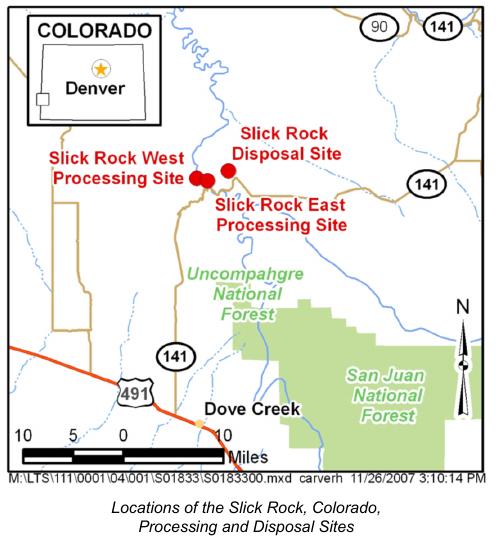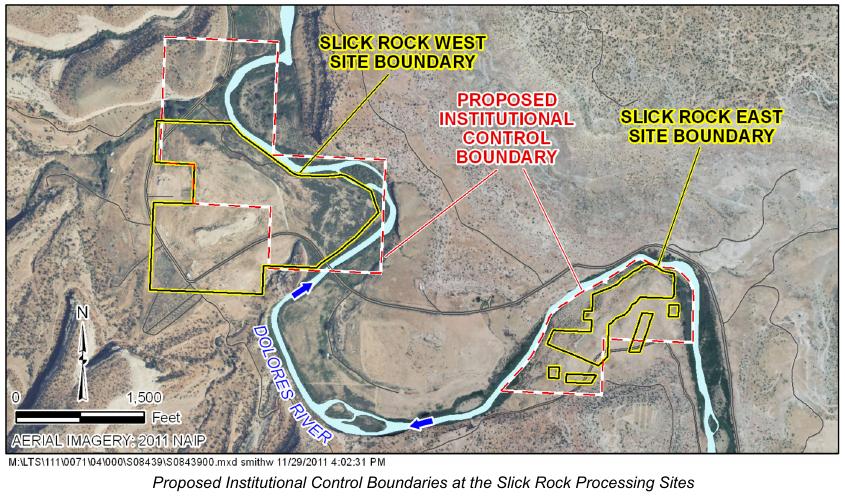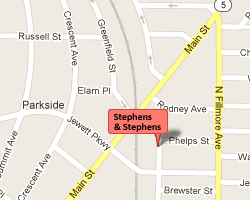Uranium Mill No. 2 In Slick Rock (West)
Home / Areas of Practice / Energy Employees Occupational Illness Compensation Program Act (EEOICPA) / EEOICP: Facility List / Uranium Mill No. 2 In Slick Rock (West)
State: Colorado
Location: Slick Rock
Time Period: DOE (Remediation) 1995-1996
Facility Type: Department of Energy
Facility Description
Vanadium and uranium was processed at this mill from 1957 through 1961. These milling operations are covered under the auspices of the Radiation Exposure Compensation Act and are not separately covered under EEOICPA. However, DOE environmental remediation contractors performed remediation under the Uranium Mill Tailings Radiation Control Act (Public Law 95-604) at Uranium Mill No. 2 in Slick rock from 1995-1996. DOE and DOE contractor employees who performed this remediation are covered under EEOICPA.
Listing
The Uranium Mill No. 2 in Slick Rock (West) is listed as a Department of Energy (DOE) site under the EEOICPA.
Uranium Mill No. 2 in Slick Rock (West) Workers
If you or your parent worked at this or any other DOE or AWE facility and became ill, you may be entitled to compensation of up to $400K plus medical benefits from the US Department of Labor. Call EEOICPA Counsel Hugh Stephens at 1-855-EEOICPA (336-4272) or fill out the form to the right, whether your claim has been accepted or denied.
We can help with all OWCP (Federal Workers Compensation) claims, impairments, wage loss and health care. 2495 Main Street, Suite 442, Buffalo, NY 14214.
Site Descriptions and History
The Slick Rock processing sites consist of two former uranium- and vanadium-ore processing facilities located in a remote area of southwest Colorado about 22 miles north of the town of Dove Creek in San Miguel County. These sites, referred to as Slick Rock East (formerly the North Continent site) and Slick Rock West (formerly the Union Carbide site), are located adjacent to the Dolores River. Slick Rock West is approximately 1 mile downstream (northwest) of Slick Rock East. Umetco Minerals Company owns both sites.
The Shattuck Chemical Company constructed the Slick Rock East mill in 1931. In 1934, North Continent Mines, Inc., acquired the facility. The mill was designed to extract radium salts and vanadium from locally mined ores. In 1945, the federal government acquired control of the facility through the Union Mines Development Corporation to supply uranium for the Manhattan Project. Union Carbide Corporation became the owner of the facility in 1957, and the mill closed in the early 1960s. The milling operations created radioactive tailings, a predominantly sandy material. In 1995, about 129,000 cubic yards of tailings and other contaminated materials were relocated to the Slick Rock disposal site, also known as the Burro Canyon disposal cell, about 5 miles east of the processing sites.
Union Carbide’s mill at Slick Rock West began operation in 1957 using a uranium-vanadium upgrading technique to process ore mined from the surrounding area. The upgraded material was shipped to the Union Carbide mill at Rifle, Colorado, for further processing. The Slick Rock West mill closed in 1961. Milling operations at the at the Slick Rock West mill also created radioactive tailings. In 1995, about 671,000 cubic yards of these contaminated materials were relocated to the Slick Rock disposal site.

Processing Sites
At both Slick Rock processing sites, groundwater in the Dolores River alluvium constitutes the uppermost aquifer. The Jurassic Wanakah and Morrison Formations underlie the river alluvium at the Slick Rock East site. These formations form an aquitard that inhibits downward migration of alluvial groundwater. The Jurassic Entrada and Navajo Sandstone Formations underlie river alluvium at the Slick Rock West site. Hydrologic data indicate there is a slight upward vertical gradient between the alluvial and Entrada aquifers. This condition inhibits groundwater flowing vertically from the alluvial aquifer down into the underlying Entrada.
Historical milling operations at both sites have created contamination in alluvial groundwater. Selenium and uranium are the main contaminants in groundwater at the Slick Rock East site. At Slick Rock West, benzene, manganese, molybdenum, nitrate, radium-226, radium-228, selenium, toluene, and uranium are the main contaminants.
Past milling operations have had no detectable effect on water quality of the Dolores River.

Share this:
EEOICPA CLAIMS
If you or your parent worked any of the DOE or AWE facilities listed on this website and became ill, you may be entitled to compensation of up to $400K plus medical benefits from the US Department of Labor.
Call EEOICPA Counsel Hugh Stephens at 1-800-548-4494, email hstephens@stephensstephens.com, or fill out the form below whether or not you have already filed a claim and even if your claim has been accepted or denied.
Contact Us
"*" indicates required fields
*note: Submission of this form does not establish an attorney-client privilege.
Contact Us
Address:
2495 Main Street, Suite 442
Buffalo, New York 14214
Phone:
(716) 852-7590
Fax:
(716) 852-7599
After Hours:
(716) 208-3525
Email Us:
R. William Stephens, Esq.
R. Hugh Stephens, Esq.
Lisa P. Neff, Esq.

